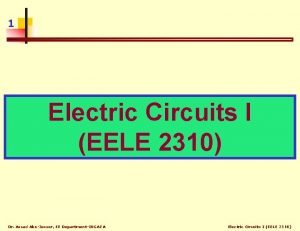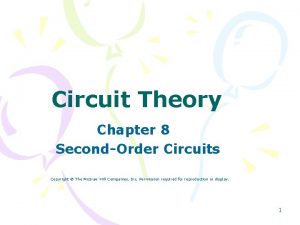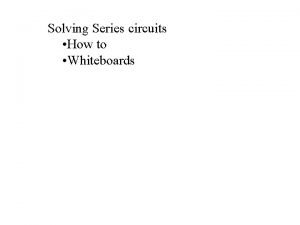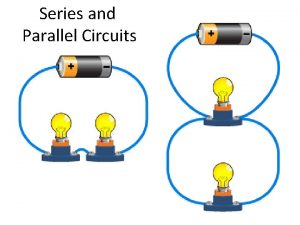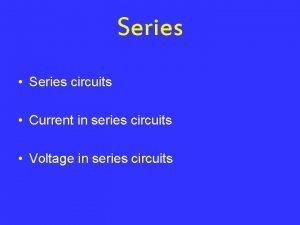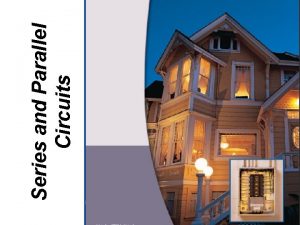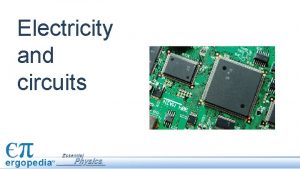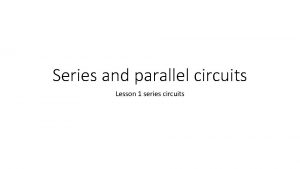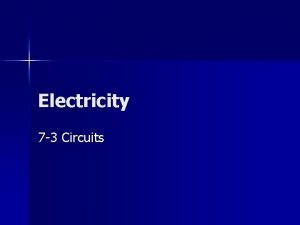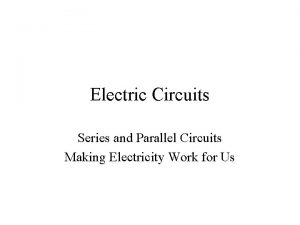Electricity Lesson 4 Series Circuits An Introduction to









- Slides: 9

Electricity Lesson 4: Series Circuits An Introduction to Series Circuits

Learning Objective To investigate current in series circuits. Success Criteria • To recall the definition of current and the unit that is used to measure it. • To draw and construct a series circuit from a description. • To explain what happens to the current as the number of bulbs in a circuit is increased.

Starter: Identify the Symbol voltmeter bulb open switch closed switch battery ammeter

What Is an Electrical Current? Current is the flow of charge around a circuit. The faster the charge flow, the higher the current. Current is measured in amps using an ammeter (always in series). The current is the same everywhere in a series circuit. It does not matter where you put the ammeter, it will give you the same reading. The current in a series circuit depends upon the number of cells. The more cells you add, the greater the current. Current is not used up. 1. 5 A

Series Circuits: the Rules When it comes to drawing series circuits, there are certain rules that we must follow every time. 1. Always draw circuits using straight lines. 2. Use a pencil and a ruler to draw these lines. Using the Introduction to Series Circuits Activity Sheet, you will now have eight minutes to draw three series circuits using the rules above. Start

Practice Exam Question Student A has made a steady-hand game. Student A has to move a metal ring along a piece of thick wire until it reaches the rest position. When Student A is moving the metal ring, it must not touch the wire. If it touches the wire, a buzzer will make a noise. The metal ring and the thick wire both allow electricity to pass through. 1. What is the scientific name for materials that allow electricity to flow through them? (1 mark) Student A covered the rest position with an insulating material. When the metal ring is put down on the rest position, the buzzer cannot work. 2. Which materials might Student A have used to insulate the wire for the rest position? (2 marks) a) copper wire b) rubber c) plastic d) aluminium foil

Extension A light bulb gets hot when it has been on for some time. Will a change in temperature have an impact on the flow of charge around the circuit? Why do you think this might be the case?

Light Bulb Moment Today, our success criteria were: • To recall the definition of current and the unit that is used to measure it. • To draw and construct a series circuit from a description. • To explain what happens to the current as the number of bulbs in a circuit is increased. Complete the sentences with a learning outcome from today. What Went Well? I can… Even Better If: I need to be able to…

 Advantages of parallel circuits over series circuits
Advantages of parallel circuits over series circuits Lesson 8 comparing series and parallel rlc circuits
Lesson 8 comparing series and parallel rlc circuits V r and i in parallel circuits ch.8:1 answer key
V r and i in parallel circuits ch.8:1 answer key Static electricity and current electricity
Static electricity and current electricity Electricity n
Electricity n Electricity and magnetism vocabulary
Electricity and magnetism vocabulary Lesson outline lesson 3 describing circuits answers
Lesson outline lesson 3 describing circuits answers Solving series circuits
Solving series circuits Compute the equivalent resistance of the network
Compute the equivalent resistance of the network Equivalent resistance of a parallel circuit
Equivalent resistance of a parallel circuit

